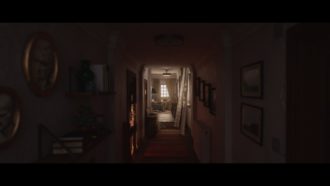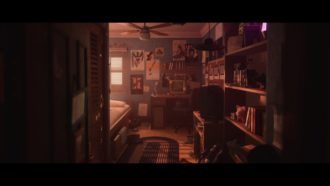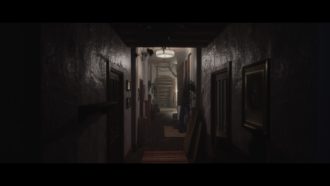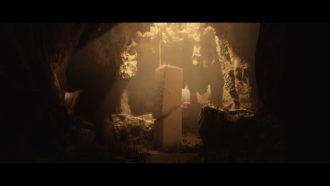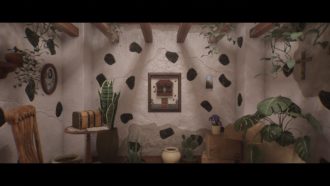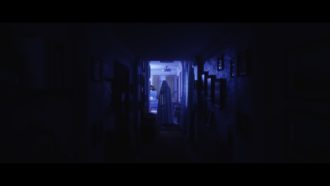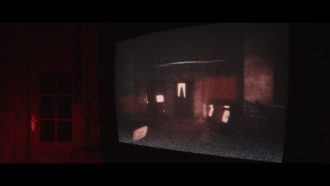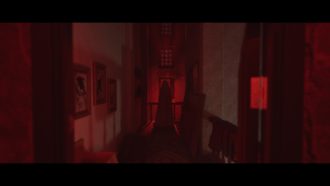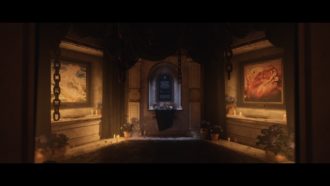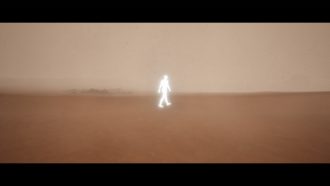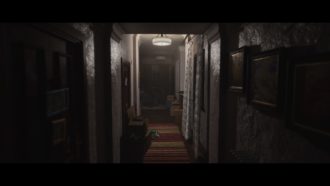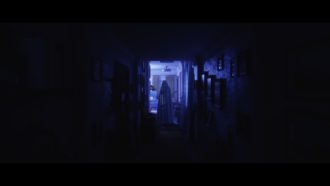Platforms:
PC, PS5, Xbox Series X|S
Released:
July 22, 2025
Publishers:
Selecta Play, Astrolabe Games
Developer:
Broken Bird Games
CW: Anxiety, depression, grief, suicide, and suicidal ideation.
Luto, developed by Broken Bird Games and published by Selecta Play and Astrolabe Games, is a story about death. A tale of grief and loss. An account of broken dreams, buried secrets, and painful lies. This is more than just a walking sim, psychological horror game about anxiety, depression, loss, and suicidal ideation. It is a hauntingly evocative and honest telling of how it feels to live with severe mental illness. To experience the cultural and societal stigmas that surround it. What it means to live a life entrenched in grief. To understand how words inform the way we think about the world and ourselves in it. And the power in calling out for help.
This is my hole, it was made for me
Luto begins just like any other game, with the protagonist, Samuel, powering through a raging desert storm before waking up from his nightmare in front of a shattered bathroom mirror, preparing for another day of work. His every move and thought is accompanied by the dulcet tones of the Narrator. But when Samuel attempts to leave his house for work, he instantly reawakens back at the mirror the following day, and the next day, and the next day, and the next day. Be it mindless repetition or something far more nefarious at play, Samuel cannot seem to escape the confines of his house. Repeating the same morning routine over and over. Besides, it’s not like he is alone; something bangs from the other side of a locked trapdoor in his basement. And upon opening the steel door, the darkness beckons him in.
My editor is telling me that this is, in fact, not how other games begin… anyway. Descending the ladder, Samuel finds himself inside a twisted recreation of his childhood home. The lights are off, the windows are covered up, and the doors are boarded shut. Illustrations from his sketchbook as a child are scattered around the house and painted on the walls. Sheeted ghosts watch him in the darkness and follow his every move as he is forced to confront the events of his past. And the once comforting monologues of the Narrator begin to turn eerily sinister, seemingly relishing in Samuel’s confusion.
“Luto is a game where going in as blind as possible is important.”
For the sake of keeping this review spoiler-free, I will refrain from revealing any further details about the game’s plot. Luto is a game where going in as blind as possible is important. Because once this introduction is over, the central mysteries of the story begin to unfold rapidly.
Luto is incredibly well-paced despite its relatively short runtime of five hours. With the story being teased out through the Narrator’s monologues, sketches you’ll find around the house, illustrations on the walls, the rooms and spaces you explore, and in sticky notes and documents that you can read until it is neatly wrapped up in a bow in the conclusion.
It is a horror game centred around its environments, delivering on the adage of show, don’t tell. And because of that, I never felt disengaged or detached while I was playing. I felt more engrossed in Luto’s phenomenal world and its honest story, its authentically unique style, its construction of characters, as well as how it played with time and space, than I have in any other video game. Luto feels like it was specifically designed for me and my love for abstract, sensory, and psychological horror. Incorporating elements of metafiction and surrealism that reminded me of one of my favourite books, House of Leaves. It encouraged my natural desire to explore the world and examine every nook and cranny. Rewarding me with tidbits of world-building and character development. In the words of Junji Ito: “This is my hole, it was made for me.”
Playing with the truth
As a horror game, Luto is undeniably scary, and the design of the areas you’ll explore has been carefully crafted so that long, winding hallways and tight corners feel threatening. They are constantly shifting and changing space in uncanny ways, disrupting the fundamental expectations of space and movement, and turning the navigation of what should be a familiar and safe space into a foreign source of fear. One of the main ideas that Luto incorporates in its horror is determining what is fact and fiction. Whether you can trust what you see, what you hear, and how you can distinguish between what is real and what is not. Frequently changing the geometry of the house, making words on a document go missing when you turn the page, and having the Narrator constantly contradict themselves adds to the horror experienced by the protagonist and the player alike.
It is also a very visually stunning game that blends photorealism with its own unique style — the full extent of which left me not only excited to keep playing, but extremely awestruck in the final half of the game due to its sheer creativity and artistry. While Luto adopts realistic graphics, it also manages to consistently perform at over 60 FPS on its highest graphical settings on an RTX 3060, never once stuttering or crashing.
“Each scare feels earned, effective, and drastically varies in setup to make each fright significantly different from one another.”
The game also bleeds atmosphere with its use of lighting to create contrast between cold and warm colours. Which is later weaponised to make the silhouettes of ghosts and other beings stand out in pitch black passages, further emphasised by a weathered film effect in its visual design, helping to build saturation in colours to create this dream-like aesthetic. This, in turn, tricks the mind into creating its own fears and monsters when grain and noise flicker in dark, poorly illuminated hallways, creating the illusion of something moving through the darkness.
Additionally, the game has plenty of jump scares. Although some of these scares do feel predictable, such as a ghost flying towards the screen in a pitch black, tight-walled corridor, they never once feel cheap. No cats’ coming out of a school locker, or gratuitously loud noises. Each scare feels earned, effective, and drastically varies in setup to make each fright significantly different from one another.
Helping bring this terrifying world to fruition is the perfectly crafted audio design and music, where every sound effect and ambient tone is clear and crisp. And the music has this smooth, everlasting, and ethereal tone to it. It’s just as immersive as it is terrifying. There is beauty in hearing every creak of the house as it breathes with life, and the weight that each step holds in it. Even the sound of ragged breath from someone, or something, lurking behind you, has this unsettling awe to it.
The various noises and bumps in the night that echo from the darkness of a world removed from natural law, outside of space and time, are all the more terrifying. While there is nothing so scary that you’ll find yourself turning the game off and watching videos of cats and dogs being best friends, even the most seasoned of horror veterans will find something that scratches that itch for a good scare.
For example, there is a sequence in Luto where you must sit in front of a television and insert a VHS tape in order to progress. You are positioned in such a way during this part where you have the TV to your right, and to your left lies a door that you need to unlock by playing out the contents of the tape. Where the hairs started to rise on the back of my neck came from the anticipation and dread that something would come onto the screen and fill that space in front of the door. That the game would capitalise on the fact that my attention was divided to frighten me. It was a dreadful feeling, and it certainly didn’t help that something was clearly behind me, making guttural breathing sounds down my neck.
The devil is in the details
One of my biggest fears coming into Luto — especially once I began to recognise the route the game’s premise, themes, and ideas were taking and the role they were playing in the narrative, the aesthetic design, and the stylistic elements — was that the game would sensationalise mental illness. Perhaps even romanticise depression, suicide, and suicidal ideation, or dare to make the player a willing participant in the action of taking one’s own life (looking at you with pure disgust and vitriol in my eyes, The Suicide of Rachel Foster).
But Luto is so far from that. It subverted every expectation I had and every false assumption I had made about the game and its story. It was nothing short of phenomenal in its horrifically honest and profound exploration of what it means to live in a deep depression for longer than you can remember. How depression strips you of joy, takes away your dreams and aspirations, your ability to feel joy, and leaves you feeling like a ghost in the spaces you inhabit. At times, it hit close to home.
“This is a game that you can’t relive; it’s a uniquely singular experience.”
Luto is poetically evocative and expertly written, never once shying away from its subject matter and constantly treating it with the level of respect it deserves. Nor does it bite more than it can chew. Images, metaphors, objects, and descriptions are so carefully placed and curated in a way that makes everything hold meaning.
Never once does it throw something haphazardly at the player to elicit an emotional response or for some sick sense of shock factor. Everything holds a deep meaning in Luto, and it does a fantastic job of rewarding the more meticulous players by providing the necessary components to have that huge lightbulb moment when you realise what certain story moments are implying. In Luto, what at first appears to be unexplainable is, in actuality, so deeply rooted in nuance that you keep thinking about it well after the credits have rolled. Things as small as black bars at the top and bottom of the screen, to the very speed at which you walk, bathe in meaning and are integral to the story being told.
Luto is a game that not only wants to tell a story about living with severe mental illness, but also comments on the idea of games as an effective tool for improving mental health literacy, seeking to give players the tools to empathise with those living with it. It creates a realistic and relatable character in Samuel and projects a genuine, empathetic, and candid display of mental illness. It allows players to understand the thoughts, feelings, and experiences of a character living with mental illness. Not only humanising them, but illustrating the fears, stigmas, and less-discussed experiences of those who live with depression and suicidal ideation. And it explores the physical and mental symptoms of mental illness to give a full account of what it means, looks like, and feels like.
This is a game that you can’t relive; it’s a uniquely singular experience, sticking with you long after you’ve finished. But it is something that should first be met with completely fresh eyes, where it is at its most impactful. While its content and themes are explicit from the get-go, with a forewarning on the main menu. The path the story takes and the messages it presents should be experienced firsthand. But because the game is so impactful its first time round, I struggled to maintain my engagement in my second playthrough. I knew the tricks it was going to play on me, and I knew what to expect going forward. This isn’t a game I’m going to go play again and again, but it is one that will stick with me for the rest of my life.
9
Amazing
Positive:
- Excellently written and filled to the brim with meaning and depth
- Tremendously scary and atmospheric
- Spectacular audio design
- Visually stunning
- Strikingly original and inherently meaningful
Negative:
- Lacks replayability
- Its subject matter may deter players
For an independent studio’s debut game, Luto strongly delivers on Broken Bird Games’ ethos of delivering deep narrative experiences that reflect both their passion for video games but also great stories. Despite being a story about death, Luto has more on its mind than presenting melodrama. It’s incredibly unique, fantastic to look at, highly atmospheric, and poetically beautiful. Devoted to those who are no longer with us, and hoping to make a change in the world by humanising the struggles of living with mental illness, Luto stands as one of the most powerful games of the year. It’s transformative, evocative, and breaks form and conventions around how a game should be and how it should play, taking the overused trope of horror as an allegory for mental illness, and making it something truly memorable. It is a game that I cannot recommend more to those in the right headspace.
